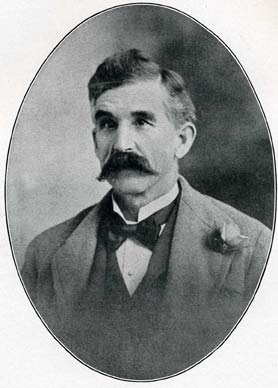‘How did Meigs Road get its name?’
-Elizabeth Hodes

Meigs Road, one of the primary routes that connects downtown Santa Barbara with the city’s Mesa neighborhood, was named after the family of Peveril Meigs. Meigs arrived in 1887 and became a farmer out on the sparsely settled Mesa.
Meigs could trace his lineage back to one Vincent Meigs (spelled Meggs at that time) who came from England and settled in Connecticut in 1637. The family became one of distinction, counting among its members a professor at Yale University, a president of the University of Georgia, a United States Surveyor-General, a U.S. Postmaster-General, and the Quartermaster-General of the Union Army during the Civil War.
Charles, Peveril’s father, bucked family tradition and, instead of entering the world of government and public service, embarked on a business career. Starting out as a cashier in a New York City bank, he eventually founded his own firm, Charles A. Meigs and Son. When an economic downtown virtually wiped him out, he bounced back to become the national bank examiner for New York, a position he held until his death.
Peveril was born in 1847 in New York City. The origin of his rather unusual first name is a bit obscure, although it may go back to the time of the Norman conquest of England in the 11th century. The young man attended the finest private schools in the city and in Brooklyn. He also demonstrated a bit of wanderlust early on; in 1867 he journeyed to the wilds of Alaska, shortly after the U.S. purchased the territory from Russia. He was one of the first Americans to travel through this remote land after Alaska came under U.S. control. His health would be poor for much of the rest of his life, perhaps in part due to the rigors of this journey.
He returned to New York City and the world of big business, working for a time with his father. His continuing health problems prompted a move to a Massachusetts farm, then to the final move to Santa Barbara, which in the late 1800s enjoyed a reputation among health seekers throughout the country.
Meigs continued his agricultural pursuits upon his arrival here and purchased 104 acres on the Mesa stretching from his namesake thoroughfare eastward to today’s Santa Cruz Boulevard. Here, Meigs grew a variety of crops including beans and pumpkins. The road that would bear his name was just a rut-filled wagon track.
In 1893, Meigs became a cofounder of El Montecito Manufacturing Company to produce olive oil. There was a tremendous demand for olive oil at that time, and one of the leaders of the industry was Goleta’s Ellwood Cooper. The group purchased land in Montecito and built a three-story mill from which Olive Mill Lane got its name. The company not only produced olive oil, believed to have a variety of medicinal qualities, but also olive oil soap and candy. The company was a growing concern until 1898, when lower tariffs forced domestic products off the market in favor of imported oil. The mill is now a residence; at one time singer Lena Horne owned it.
Meigs was also involved in community affairs. He was the leader in bringing electric lighting to the Mesa, and he sat among the high counsels of Trinity Episcopal Church. Sometimes his activities led to problems; his obituary makes reference to the fact that for a time he had to carry a firearm in self-defense due to some unspecified controversy.
Meigs died in 1921, eulogized as a community leader. The farms of the Mesa have long since disappeared to make way for housing. The name of Meigs Road is a link back to a time when the Mesa was farmland connected to the city by a rut-filled wagon track.



